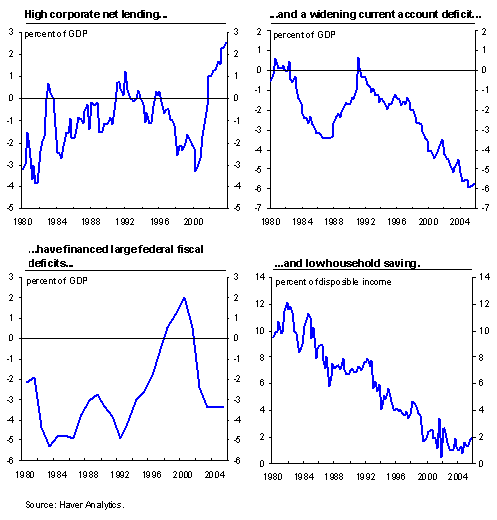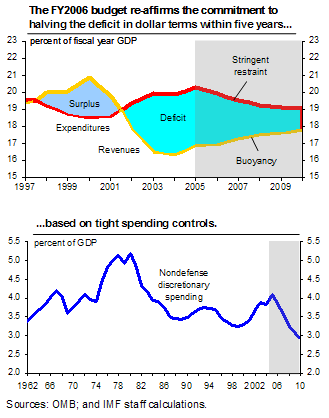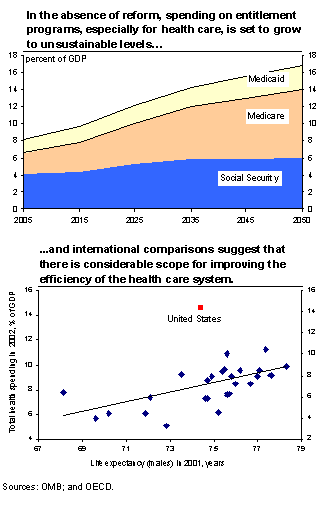United States of America -- 2005 Article IV Consultation, Concluding Statement of the IMF Mission
May 25, 2005
1. The United States has continued to be the main locomotive of global growth. Over the past year, the expansion has solidified as robust productivity growth and high corporate profits have contributed to a strong rebound in business investment and an acceleration in employment. As the output gap has narrowed, the policy focus has appropriately shifted toward a steady removal of stimulus in a manner that supports macroeconomic stability and sustained growth.
2. Looking ahead, there is general agreement that the U.S. outlook for 2005 and 2006 appears broadly favorable. As the expansion matures, GDP growth is projected to slow to around 3½ percent in the coming two years, reflecting the withdrawal of policy stimulus, higher oil prices, and the return of the household saving rate to a more sustainable level, partly offset by a diminution of the drag from net exports. Although productivity growth is projected to ease somewhat, the remaining small output gap would help contain inflationary pressures. Nonetheless, the current account deficit is likely to remain around its recent record highs, in part because increasing U.S. foreign indebtedness and higher interest rates cause the net factor income balance to weaken.
|
3. While the U.S. economy is again expected to outperform other G-7 members, the challenge is to safeguard the outlook from the considerable uncertainties and risks, particularly against the background of looming demographic challenges.
4. These considerations underscore the importance of U.S. leadership in implementing the G-7 Agenda for Growth. In combination with structural reforms and greater exchange rate flexibility in major trading partners, the key challenge for the United States will be to achieve fiscal consolidation and higher national saving. Together with policies to address long-term fiscal sustainability and maintain high productivity growth, this would provide a solid basis for continuing economic prosperity. Monetary policy 5. The Federal Reserve has successfully balanced the need to support activity while preserving price stability in recent years. After having injected extraordinary stimulus over the downturn, the Fed appropriately reversed course in mid-2004 as the expansion became increasingly self-sustained and deflation risks receded, and has since raised the federal funds rate in 25 basis point moves to 3 percent. 6. The mission supports the Federal Reserve's gradual and flexible approach to monetary tightening. The Fed's commitment to price stability has ensured that inflation expectations have remained anchored in the face of substantial shocks to energy and other commodity prices. Coupled with a skillful communications strategy, this has strengthened the expectations channel and enabled a gradual pace of tightening. At the same time, the past year has also witnessed substantial changes in market forecasts of the pace of future interest rate hikes, illustrating confidence in the Fed's willingness to respond rapidly to changing circumstances. While expectations of tightening have recently been scaled back, the Federal Open Market Committee's (FOMC's) May 3 statement has appropriately cautioned that more forceful action would be required if price pressures continued to intensify. 7. The Federal Reserve is highly transparent and its communications strategy is highly effective. Several steps have recently been taken to further increase transparency—including shortening the publication lag for FOMC minutes and extending the horizon of forecasts. More fundamentally, the Committee has also debated whether to adopt an explicit inflation objective. As we have suggested before, the experience in other countries illustrates that defining the central bank's inflation objective more clearly can help further anchor inflation expectations and long-term bond yields, without unduly constraining the ability of policymakers to meet shorter-term stabilization objectives.
Fiscal policy 8. The Administration's call for deficit reduction is welcome. The FY 2004 outturn was significantly better than expected; recent tax revenue data suggest overperformance in FY 2005; and this year's Budget Resolution has endorsed the goal of halving the nominal deficit by FY 2009. That said, budget targets for next year and beyond do not appear ambitious—the structural budget balance would only improve by around 1½ percent of GDP through FY 2009. Moreover, the assumed compression in the ratio of nondefense discretionary spending is unprecedented, and no account has been taken of funding for operations in Iraq and Afghanistan after FY 2006 or of pressures to limit the growing scope of the Alternative Minimum Tax. 9. The current favorable growth conjuncture suggests room for bolder deficit reduction over the coming years. Annual reductions in the fiscal deficit of roughly 1 percent of GDP through structural measures over the next few years—aimed at achieving a balanced budget excluding Social Security early in the next decade—would ease the burden on monetary policy to contain inflation pressures as the economy returns to full employment and could likely be achieved without placing an undue drag on activity. It would also support national saving, domestic investment, and the external position, forming an important pillar in the international strategy for reducing external imbalances and the associated vulnerabilities. Most importantly, by significantly lowering the federal debt ratio over time, it would provide fiscal room to cope with impending pressures on health and retirement programs and reduce the burden on future generations. 10. Expenditure discipline will be an essential part of any deficit reduction, but tax reform should also play a role in supporting fiscal sustainability. The President's Advisory Panel on Federal Tax Reform has been charged with reporting on ways to simplify the tax system and improve its efficiency—an undertaking that the mission strongly supports—in a revenue-neutral manner. However, the magnitude of the fiscal adjustment needed and the strict spending discipline already assumed make it seem prudent to explore options for revenue enhancements. Measures that would help avoid having to unwind recent tax rate cuts and their associated supply-side benefits include broadening the income tax base by curbing deductions, such as the generous treatment of mortgage interest, or introducing a national consumption-based tax. 11. A legislated budget rule could help support fiscal responsibility. Both domestic and international experience suggests that legislated budget rules can be helpful in enhancing budget discipline, particularly if supported by political consensus. However, the expiration of the Budget Enforcement Act (BEA) seems to have coincided with a weakening of fiscal discipline, including through the use of sunset provisions in recent tax legislation. The Administration has re-iterated its support for a number of useful proposals, but it is unfortunate that these have not been carried forward, and that pay-as-you-go provisions would be limited to expenditure measures.
Entitlement reform 12. Reforms of retirement and (in particular) health care entitlement programs are essential for long-term fiscal sustainability. Although much of the recent debate has been on Social Security, federal health care spending has been rising at a much faster pace, reflecting cost pressures on the broader U.S. health care system. Coupled with the new prescription drug benefit and the rise in the elderly population in coming decades, the unfunded liability of the Medicare system has been estimated at 200 percent of GDP over the next 75 years, dwarfing the 30 percent of GDP liability of the Social Security system. 13. It is questionable whether Medicare spending can be contained without reforms to the overall health care sector. The public sector already finances about half of all U.S. health spending, including through the Medicare and Medicaid programs, and total U.S. health care outlays are nearly twice the OECD average as a share of GDP, without seeming to yield commensurate benefits in terms of health outcomes. Administration proposals—including malpractice reform—together with the provisions of the 2003 Medicare Modernization Act could help moderate price pressures, but the added prescription drug benefit significantly worsened Medicare's financial position. With the Medicaid system under similar strains, a large uninsured population, growing numbers of the elderly, and a projected tripling of public health care outlays as a ratio to GDP in coming decades, further steps are urgently needed to improve the efficiency of the system. 14. We welcome the current debate on measures to address the solvency of the Social Security system. The Administration has helpfully lent its support to the principle of "progressive price indexation," which would significantly reduce Social Security's unfunded liabilities by curbing the growth of accrued benefits for higher-income households. The emphasis on containing benefit growth appears appropriate, but additional options should be considered to help eliminate the funding shortfall, such as an increase in the retirement age or raising the cap on the Social Security payroll tax. However, as we have emphasized in previous years, the key priority is to ensure that reforms that fully fund the system are not delayed, since this would only increase the adjustments that will eventually be needed. 15. The Administration proposal to permit younger workers to divert a portion of their Social Security contributions into personal retirement accounts (PRAs) would pose fiscal challenges. While PRAs hold the potential for raising the return on Social Security contributions, they would also imply a significant increase in federal deficits and debt in coming decades as off-budget liabilities are recognized, albeit offset over time by lowering future benefits as the PRAs mature. Even if such instruments were to be introduced, it would be essential that they be coupled with other measures that assure the long-run solvency of the Social Security system. Structural policies 16. Structural reforms to support saving and capital accumulation would help sustain high labor productivity growth. Recent Administration initiatives are aimed at establishing an "ownership society" by lowering taxes on capital income and facilitating access to capital markets for a wider segment of the population. The steady decline in coverage by defined-benefit pension plans and employer-sponsored health care plans in recent years has meant that financial risks carried by households have already been increasing. This suggests the importance of public policies that encourage appropriate saving decisions, such as by promoting retirement plans in which participation is the default option. 17. The U.S. financial sector has proven exceptionally resilient in recent years, but there remains scope for further reform. The Administration has taken the welcome step of proposing legislation to strengthen the supervision and limit the size of the housing government sponsored enterprises (GSEs) to contain systemic risk in mortgage markets. Recent developments—including the large new liabilities taken on by the Pension Benefit Guarantee Corporation—illustrate the need for reforms that increase funding requirements and strengthen risk-based premiums for defined-benefit pension plans. Moreover, recent irregularities in the insurance sector suggest that there may be a need to supervise systemically important entities on a national level. 18. As demonstrated by last year's framework agreement for the Doha Round, the United States has an important leadership role in the quest for global trade liberalization. The mission welcomes Administration proposals to reduce agricultural subsidies, as well as plans to offer and elicit stronger commitments for liberalization in services. At the same time, specific areas for U.S. leadership would be to ensure that bilateral free trade agreements complement the multilateral framework so as to minimize the potential costs of regionalism and to achieve significant increases in market access, particularly for agricultural products. It is also imperative to resist protectionist responses to the recent surge in Chinese imports, including those related to the expiry of the Agreement on Textiles and Clothing. 19. Recent increases in U.S. official development assistance (ODA) and progress on the Millennium Challenge Account are welcome. However, U.S. ODA relative to GNI remains among the lowest across industrial countries and argues for continued efforts to boost U.S. foreign assistance. |
IMF EXTERNAL RELATIONS DEPARTMENT
| Public Affairs | Media Relations | |||
|---|---|---|---|---|
| E-mail: | publicaffairs@imf.org | E-mail: | media@imf.org | |
| Fax: | 202-623-6278 | Phone: | 202-623-7100 | |










